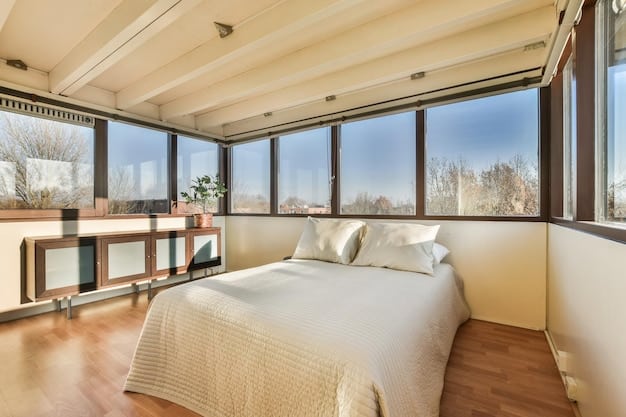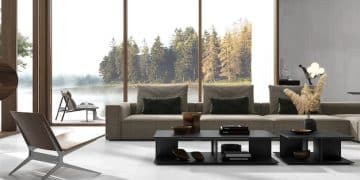Maximize Natural Light: Expert Tips for a Brighter Home

Anúncios
Efficiently maximizing natural light in your home involves strategic design choices and targeted decor solutions that enhance illumination, create an expansive feel, and positively impact both aesthetics and well-being, transforming any interior space into a more vibrant and inviting environment.
Transforming your living space by amplifying natural light is more than just an aesthetic upgrade; it’s an investment in your home’s ambiance and your well-being. Learning to effectively maximize natural light: expert tips for brightening your home’s interior can dramatically alter the perception of space, mood, and even energy efficiency, creating a vibrant and welcoming atmosphere.
understanding the science of light and space
Natural light isn’t just about brightness; it’s about the quality of light—its color temperature, intensity, and how it interacts with the surfaces in a room. Understanding these elements is crucial for anyone seeking to enhance their home’s interior. The way light enters and reflects within a space can profoundly influence perceptions of size, warmth, and overall appeal.
The science behind natural light involves more than just opening a window. It’s about optimizing the journey of light from its source to every corner of your room. Factors such as window placement, the orientation of your home, and even the time of day can play a significant role. Effective use of natural light can reduce reliance on artificial lighting, leading to energy savings and a more sustainable living environment.
The psychology of natural light
Natural light has a profound impact on human well-being. Exposure to daylight can regulate circadian rhythms, leading to better sleep and improved mood. Studies have shown that ample natural light can reduce stress, increase productivity, and even alleviate symptoms of seasonal affective disorder (SAD).
- Improved mood and concentration: Natural light stimulates serotonin production.
- Better sleep quality: Exposure to daylight helps regulate the body’s internal clock.
- Reduced eye strain: Less reliance on artificial lights lessens visual fatigue.
- Enhanced aesthetic appeal: Natural light makes colors truer and spaces more inviting.
Beyond its psychological benefits, natural light also plays a key role in the perception of color within your home. Colors appear richer and more vibrant under natural light, compared to the often-distorted hues seen under artificial illumination. This means that interior paint colors, furniture, and decor items will present their true intentions, contributing to a cohesive and appealing design.
Considering the angle and intensity of sunlight throughout the day is also important. South-facing windows typically receive the most consistent light, while north-facing windows offer a softer, more diffused light. East-facing windows provide bright morning light, and west-facing windows offer warmer, afternoon light. Tailoring your decor and activities to these light patterns can significantly enhance your living experience.
Understanding the interplay between light and shadow is an art. Too much direct sunlight can cause glare and heat gain, while too little can make a room feel dim and uninviting. Balancing these elements involves strategic planning, from window treatments to furniture arrangement. The goal is to create a dynamic and comfortable environment that adapts to the changing light conditions of the day.
In conclusion, appreciating the science of light is the first step toward transforming your home. By understanding its physical properties and psychological effects, you can make informed decisions that maximize its potential, creating spaces that are not only brighter but also healthier and more pleasing to the eye.
strategic window treatments and their impact
Window treatments are more than just decorative elements; they are powerful tools for controlling and enhancing natural light. The right treatment can transform a room, diffusing harsh sunlight, ensuring privacy, and improving energy efficiency. Choosing the appropriate style and material is essential to achieving your desired lighting effect without sacrificing functionality or aesthetics.
When selecting window treatments, consider the orientation of your windows and the amount of privacy needed. For rooms flooded with intense sunlight, options that diffuse light are preferable. For spaces that require more privacy but still benefit from natural light, semi-sheer or translucent materials are ideal. The goal is to strike a balance between light control and maintaining an open, airy feel.
Selecting the right fabrics and materials
The material of your window treatments significantly impacts how light enters and interacts with your room. Sheer fabrics allow maximum light penetration while offering a degree of privacy, creating a soft, diffused glow. Heavier fabrics, on the other hand, provide excellent light blocking and insulation.
- Sheer curtains: Offer privacy while maximizing light.
- Linen and cotton blends: Provide a natural texture with good light diffusion.
- Woven wood shades: Add warmth and texture, filtering light gently.
- Smart blinds: Allow precise control over light levels via automation.
Consider the color of your window treatments as well. Lighter colors reflect more light, helping to brighten a room, while darker colors absorb light, making a space feel cozier or more intimate. If your primary goal is to maximize natural light, lighter shades are generally the best choice.
Beyond fabric and color, the design and mounting of your window treatments also play a role. Mounting curtain rods wider and higher than the window frame can make windows appear larger and allow curtains to be drawn completely off the glass, maximizing the visible window area and the influx of light. This simple technique can visually expand a room and enhance its overall brightness.

Another innovative approach is to use dual window treatments, such as having a combination of sheer blinds for daylight and opaque drapes for nighttime privacy or complete light blockage. This provides flexibility and control, allowing you to adapt to changing light conditions and personal needs throughout the day and night. For instance, on a sunny day, you might entirely rely on the sheer layer for diffused light, while on a cooler evening, you could opt for full drapes for insulation and a cozier ambiance.
Ultimately, strategic window treatment selection is about balancing aesthetics with functionality. By carefully choosing materials, colors, and mounting techniques, you can effectively manage natural light, enhance privacy, and contribute to the overall design harmony of your home. It’s an essential step in maximizing the brightness and appeal of your living spaces.
the art of reflective surfaces and decor
Harnessing natural light isn’t solely about windows; it’s also about how light bounces around your interior. Reflective surfaces and strategically placed decor can act as secondary light sources, carrying light deeper into rooms and illuminating darker corners. This approach not only brightens a space but can also make it feel larger and more open, creating an inviting and dynamic environment.
The key to effective light reflection lies in understanding which materials and finishes best scatter light rather than absorbing it. Mirrors are the most obvious choice, but numerous other elements, from metallic accents to glossy paint, can contribute to a brighter interior. The goal is to create a harmonious interplay between incoming light and the surfaces that interact with it.
Mirrors: more than just reflections
Mirrors are perhaps the most effective tool for amplifying natural light. Placed strategically, they can double the light in a room by reflecting it from windows or other light sources. Beyond simply reflecting light, mirrors can also create the illusion of more space, making small rooms feel larger and more open.
- Opposite a window: Maximizes reflected light and views.
- Behind a light source: Increases the output of lamps.
- Large floor mirrors: Create depth and disperse light widely.
- Mirrored furniture: Adds subtle reflections and glamour.
Consider placing a large mirror directly opposite a window to capture the view and reflect it back into the room, effectively extending the outdoor scenery indoors. Alternatively, positioning a mirror adjacent to a window can also help distribute light more evenly throughout the space. The size and shape of the mirror can also influence its effect, with larger mirrors generally providing more impactful results.
Beyond traditional mirrors, other reflective surfaces can also contribute significantly. Polished chrome, glass, and highly lacquered finishes are excellent for bouncing light. Incorporating these materials through furniture, accessories, or even architectural elements can add subtle sparkle and enhance overall brightness without being overwhelming. For example, a glass coffee table or a high-gloss side table can introduce reflective qualities to a room’s lower planes.
The strategic use of metallic accents is another powerful technique. Silver, gold, and bronze elements, whether in picture frames, decorative objects, or light fixtures, catch and reflect light, adding warmth and sophistication. Even the texture of a fabric can influence its reflective properties; silk and satin tend to have a higher sheen than matte cottons, allowing them to reflect more light.
When curating decor, remember that less can be more. Overly cluttered spaces can absorb light and make a room feel smaller and dimmer. Opt for minimalist decor with clean lines and reflective or light-colored finishes to promote an open, airy feel. This approach allows light to travel freely, enhancing the overall brightness of your home.
By thoughtfully integrating mirrors and other reflective surfaces into your home decor, you can create a luminous and expansive environment that maximizes the benefits of natural light. It’s an artistic approach that combines functionality with aesthetic appeal, transforming any room into a brighter, more inviting sanctuary.
the power of color palettes and finishes
The colors and finishes you choose for your walls, floors, and furniture play a pivotal role in how natural light is perceived and distributed throughout your home. Light colors reflect light, making spaces feel brighter and larger, while darker colors absorb it, creating a cozier, more intimate atmosphere. To truly maximize natural light, a strategic approach to your color palette is essential.
Beyond just color, the finish—whether matte, satin, eggshell, or gloss—also impacts light reflection. Glossier finishes tend to reflect more light, adding a subtle sheen that can enhance brightness. Understanding this interplay allows you to make informed decisions that support your goal of a lighter, more airy home.
Dominating with light hues
Opting for light-colored paints, especially whites, creams, and pale grays, is a fundamental step in maximizing natural light. These colors have high light reflectance values (LRV), meaning they bounce light back into the room rather than absorbing it. This creates an illusion of increased space and brightness.
- White walls: Reflect maximum light, ideal for darker rooms.
- Pale pastels: Add subtle color while maintaining brightness.
- Glossy finishes: Enhance light reflection on walls and trim.
- Monochromatic schemes: Create a seamless, expansive feel.
When selecting white paint, be mindful of its undertones. Cool whites with blue or gray undertones can make a room feel crisp and modern, while warm whites with yellow or beige undertones can create a softer, more inviting ambiance. Test swatches on your walls to see how they appear under different lighting conditions throughout the day.
Ceilings are often overlooked, but painting them a lighter color than your walls, or even a pure white, can make a significant difference. A bright ceiling helps to bounce light downwards and outwards, making the room feel taller and more expansive. This creates a sense of openness that complements the natural light flowing in from windows.
The color of your flooring also impacts light distribution. Light-colored flooring, such as light wood, pale tiles, or light-colored carpets, can reflect light upwards, contributing to the overall brightness of a room. Conversely, dark flooring can absorb light, potentially making a space feel heavier. If replacing flooring isn’t an option, consider adding light-colored area rugs to introduce reflective surfaces.
Furthermore, consider furniture and decor items. Choosing light-colored upholstery, translucent tables, and open shelving can prevent a room from feeling visually heavy and obstructing light. The goal is to create a cohesive palette where every element contributes to the overall luminosity. By making conscious choices about colors and finishes, you can dramatically enhance the amount of natural light in your home, creating a space that feels bright, airy, and truly inviting.
strategic furniture placement and layout
Even with ample windows and reflective surfaces, the way you arrange your furniture can significantly impact how natural light flows through your home. Poorly placed items can block windows, create dark corners, and impede the diffusion of light. Strategic furniture placement is key to optimizing light distribution, ensuring every part of your room benefits from natural illumination.
The goal is to create an open and airy layout that allows light to travel freely and reach deep into the space. This involves considering not just where furniture is placed, but also its size, height, and visual weight. An uncluttered environment is inherently brighter, as there are fewer obstacles to absorb or obstruct light.
Keeping windows clear and views open
The most fundamental rule for maximizing natural light is to keep windows unobstructed. Avoid placing tall or bulky furniture directly in front of windows, as this can block the entry of light. Instead, opt for low-profile pieces or arrange furniture in a way that frames the windows rather than covering them.
- Low-profile furniture: Allows light to pass over easily.
- Minimalistic approach: Reduces visual clutter that can absorb light.
- Open shelving: Less obstructive than solid cabinets.
- Furniture with legs: Allows light to flow underneath, reducing shadows.
Consider the height of your furniture. Taller pieces, like bookshelves or large cabinets, should be placed against solid walls rather than near windows. If you must place furniture near a window, choose pieces that are lower than the windowsill or have an open design, such as a bench with slender legs.
Creating open pathways and clear sightlines within a room also contributes to light maximization. When light can travel unimpeded from the window through various zones of the room, it distributes more evenly. This means avoiding placing large pieces of furniture directly in the center of a room if it disrupts the flow of light. Instead, arrange seating around the perimeter or create distinct zones using rugs rather than solid barriers.

Another effective strategy is to arrange seating areas to face windows or to be perpendicular to them. This allows occupants to enjoy the natural light and views directly. For dining areas, placing the table near a window can create a bright and inviting space for meals, especially during the day.
Transparent or translucent furniture, such as glass or acrylic tables and chairs, can also contribute to an airy feel. These pieces allow light to pass through them, minimizing their visual impact and preventing them from casting significant shadows. They add functionality without detracting from the room’s brightness.
In essence, strategic furniture placement is about creating a layout that invites light into every part of your home. By keeping windows clear, opting for low-profile pieces, and fostering an open design, you can ensure that natural light is not just present but effectively distributed, enhancing the luminosity and spaciousness of your interior.
innovative architectural and structural changes
While many light-maximizing tips focus on decor, for those willing to invest, architectural and structural changes can fundamentally transform a home’s access to natural light. These modifications, though more substantial, offer the most dramatic and lasting improvements, creating truly light-filled spaces.
From expanding existing openings to adding entirely new structures, these changes aim to increase the direct influx of sunlight and its subsequent diffusion throughout the interior. Such alterations require careful planning, considering structural integrity, energy efficiency, and overall design aesthetics to ensure a harmonious outcome.
Expanding windows and doors
The most direct way to increase natural light is to enlarge existing window openings or install larger windows. Floor-to-ceiling windows, sliding glass doors, or bifold doors can dramatically open up a space, blurring the lines between indoor and outdoor environments and flooding rooms with light.
- Larger windows: Maximizes direct light entry.
- Glass doors: Connects indoors with outdoors, enhancing light.
- Transom windows: Adds light above existing doors/windows.
- Window walls: Offers panoramic views and extensive light.
Consider replacing standard windows with bay or bow windows, which project outwards, allowing light to enter from multiple angles. This design can also create cozy nooks or display areas that benefit from increased illumination. Similarly, adding sidelights or transoms (small windows above a door or window) can introduce more light without requiring major structural changes to the primary opening.
For homes with limited wall space or challenging orientations, introducing new light sources from above can be incredibly effective. Skylights and sun tunnels (tubular daylighting devices) are excellent options for bringing overhead light into interior rooms, hallways, or bathrooms that lack direct window access. Skylights provide a grand influx of light and can offer views of the sky, while sun tunnels are more discreet and can fit into tighter spaces.
Opening up interior walls or creating open-concept layouts is another powerful structural change. By removing non-load-bearing walls between rooms, light can flow unobstructed from one space to another, creating a more expansive and brighter environment. This approach also improves spatial connection and can make a home feel significantly larger and more cohesive.
Another advanced solution is the integration of light shelves or light pipes. Light shelves are horizontal reflectors installed above windows that bounce sunlight deeper into a room, reducing glare near the window while increasing illumination further inside. Light pipes, on the other hand, are highly reflective tubes that capture sunlight from the roof and deliver it to interior spaces, even multiple floors below.
While these architectural changes involve a greater investment of time and resources, their impact on natural light and the overall ambiance of a home is unparalleled. They create spaces that are fundamentally brighter, healthier, and more connected to the outdoor environment, proving to be a worthwhile endeavor for truly maximizing natural light.
maintaining and optimizing your bright space
Once you’ve invested in maximizing natural light in your home, regular maintenance and ongoing optimization are essential to ensure your spaces remain as bright and inviting as possible. Over time, dust, dirt, and changes in the surrounding environment can diminish the effectiveness of your light-enhancing strategies. proactive measures can preserve the luminosity you’ve worked to achieve.
Maintaining a bright space is not just about keeping things clean; it also involves periodically reassessing your setup, adapting to seasonal changes, and being mindful of how new additions to your decor might impact light flow. A pristine and clutter-free environment is naturally more reflective and light-filled.
Regular cleaning: a simple yet powerful step
One of the simplest yet most effective ways to maintain maximum natural light is regular cleaning. Dirty windows, dusty mirrors, and grimy light fixtures can significantly reduce the amount of light entering and reflecting within your home. A consistent cleaning routine ensures that light can flow freely and unhindered.
- Clean windows monthly: Removes grime that blocks light.
- Dust reflective surfaces: Ensures mirrors and glossy finishes shine.
- Wash sheer curtains periodically: Prevents fabric from looking dingy.
- Clear outdoor obstructions: Trim trees or shrubs blocking windows.
Pay particular attention to your windows. Exterior window cleaning is just as important as interior cleaning, as outdoor pollutants can accumulate rapidly and create a dull film. For hard-to-reach windows, consider professional cleaning services to ensure thoroughness and safety.
Beyond windows, regularly dust and wipe down all reflective surfaces, including mirrors, glass tabletops, and metallic decor. Even a thin layer of dust can significantly reduce their reflective properties, making a room appear dimmer. Keep light-colored walls clean as well, as scuffs and marks can absorb light and detract from the overall brightness.
Consider the exterior environment of your home. Overgrown trees or shrubs close to windows can block a significant amount of natural light. Regular pruning of these plants can open up views and allow more sunlight to penetrate your interior. This also helps maintain the health of your plants and prevents potential damage to your home’s exterior.
Adjust your window treatments seasonally. In warmer months, you might want to use light-filtering blinds or sheer curtains to reduce glare and heat gain while still allowing ample light. In colder months, you might prefer to open curtains wide during the day to maximize sunlight warming your home, and then close them at night for insulation.
Finally, periodically evaluate your interior layout. As new furniture or decor items are introduced, ensure they don’t inadvertently block light paths or create unwanted shadows. Small adjustments can often make a big difference, ensuring that your home consistently benefits from the full potential of natural light.
By incorporating these maintenance and optimization strategies into your routine, you can ensure that your efforts to maximize natural light continue to pay off, keeping your home bright, airy, and inviting year-round.
| Key Strategy | Brief Description |
|---|---|
| ✨ Reflective Surfaces | Utilize mirrors and glossy decor to bounce light around the room. |
| 🎨 Light Color Palettes | Choose white or pale shades for walls, ceilings, and floors to enhance brightness. |
| 🌳 Clear Obstructions | Keep windows clear of furniture and prune outdoor foliage. |
| 🪟 Strategic Window Treatments | Opt for sheer curtains or mount rods high and wide to maximize glass exposure. |
Frequently Asked Questions About Natural Lighting
By maximizing natural light, you reduce your reliance on artificial lighting during the day. This directly lowers electricity consumption, which translates to savings on your energy bills. Additionally, strategic use of natural light can contribute to passive heating in colder months, further enhancing energy efficiency.
Too much direct sunlight can lead to excessive heat gain in warmer climates, increasing the need for air conditioning. It can also cause glare, fade furniture and fabrics, and compromise privacy. Balancing light with appropriate window treatments or architectural features is crucial to mitigate these potential drawbacks.
Large windows, such as picture windows, casement windows, and sliding doors, are excellent for maximizing light. Bay and bow windows also allow light from multiple angles. For rooms without exterior walls, skylights and sun tunnels are highly effective for introducing overhead natural illumination.
While plants don’t directly enhance light in the way reflective surfaces do, strategically placed plants can thrive in light-filled spaces and contribute to a fresh, vibrant atmosphere. They can also subtly diffuse light and add texture. Avoid placing large plants where they might obstruct light from entering windows.
Artificial lighting plays a crucial role in complementing natural light, especially during evenings or on cloudy days. Use layered lighting—ambient, task, and accent—to mimic the warmth and distribution of natural light when it’s unavailable. Opt for bulbs with a color temperature similar to daylight for a seamless transition.
conclusion
Embracing the principles of natural light maximization is a transformative journey for any home. By understanding its scientific properties, strategically choosing decor, optimizing layouts, and even considering architectural enhancements, you can create spaces that are not only visibly brighter but also more inviting, energy-efficient, and conducive to well-being. The continuous effort in maintaining these brilliant spaces ensures that your home remains a sanctuary of light and comfort, reflecting a conscious design choice that prioritizes both beauty and functionality. Ultimately, a home bathed in natural light is a testament to thoughtful living and an enhanced connection to the world outside.





